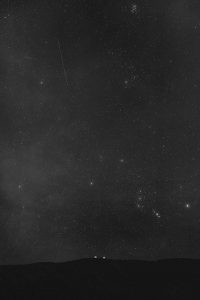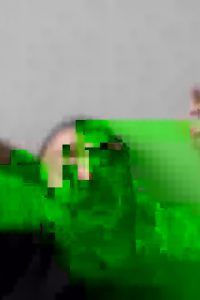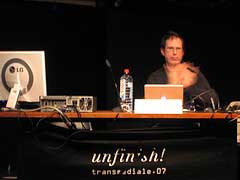 Rokeby who has a piece at the exhibition –Taken, gave a talk two days ago at the Salon. He started with a short review of his work, then discussed Taken and other works that investigate the surveillance area and ended by presenting some of his latest works. I’m not going to insist on the first part because i’m not exactly a fan of his work but the artist had a number of interesting comments on our surveillance society, interactivity and artistic tools.
Rokeby who has a piece at the exhibition –Taken, gave a talk two days ago at the Salon. He started with a short review of his work, then discussed Taken and other works that investigate the surveillance area and ended by presenting some of his latest works. I’m not going to insist on the first part because i’m not exactly a fan of his work but the artist had a number of interesting comments on our surveillance society, interactivity and artistic tools.
Just a few words about Taken, the surveillance installation provides two readings of the activities in the gallery space. On the left hand side of the projection, visitors are extracted from the ground of the gallery floors and walls, and then looped back onto themselves at 20 second intervals. Every action that has taken place in the gallery occurs together on the screen, repeating every 20 seconds. The right hand side is a catalog of the gallery visitors. Individual visitors are tracked within the space. Their heads are zoomed in on, and adjectives are attributed to them (i.e. i was “unconcerned” and later on, i was “taken”). These individual head shots are collected as a set of the last 200 visitors and presented as a matrix of 100 or occasionally all 200 shots, moving in slow motion.
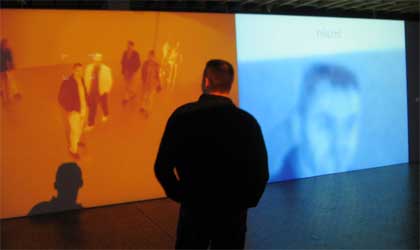
When working on the theme of surveillance Rokeby likes to play with ambiguity. On the one hand there’s the pleasure of voyeurism and on the other one there’s of course the Big Brother aspect of the activity. Taken is not as ambiguous as one of his previous pieces called Watch, it clearly has a critical stance on surveillance. He started working on the project for the Science Museum in London. Because of the IRA many surveillance cameras were installed in London and the public accepted the idea of a surveilled state much before the USA did. Some of these cameras are supposed to recognise suspicious behaviour. Rokeby was interested by questions such as: how do you come up with an algorithm able to detect suspicious actions? How do you make the machine make human judgements?
The choice of adjectives from a given set is totally random (unlike in The Giver of Names, a piece currently shown at the ZKM), reflecting on the fact that governmental agencies are claiming that researchers come up with code that is able to make discriminations, so he felt it was more honest to fake it and make us reflect about a machine that is making decisions about us,
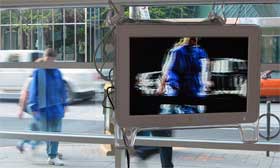 He discussed other recent pieces such as Sorting Daemon. The system looks out onto the street for moving things that might be people. When it finds what it thinks might be a person, it removes their image from the background. The extracted person is then divided up according to areas of similar colour.
He discussed other recent pieces such as Sorting Daemon. The system looks out onto the street for moving things that might be people. When it finds what it thinks might be a person, it removes their image from the background. The extracted person is then divided up according to areas of similar colour.
The piece was triggered by Rokeby’s concerns about the increasing use of automated systems for profiling people as part of the “war on terrorism”. After 9/11 there’s been an explosion of new surveillance products. Until 9/11 their manufacturers were afraid to release them to the public whom they though would find the technology too invasive. After the tragedy people were much more receptive to anything that could provide them with a sense of security.
Another recent piece: Machines For Taking Time commissioned by Oakville galleries. A zoom camera is capturing 1080 images each day (a million images in the database over 4 years) of the very same space. The installation constructs a continuous pan that is slipping through time. A single cycle takes about 20 mins, taking us through micro-narratives of people who pass by to larger narratives (the seasons). Rokeby is working on a second version, this time it will be looking over the city of Montreal.
Completely different piece, Cloud, for the Ontario Science Center is a very large kinetic installation made of hundreds of mirrors with motors attached. They rotate across 2 axis and shift through different phases, sometimes synched, sometimes not, sometimes wave-like patterns. The sculpture is completely different from every angle you watch it because of the perspective, of the way light is reflected, etc.
Now what was interesting was the Q&A that followed the talk. Andy Polaine noted that Rokeby had first shown a series of interactive pieces but his most recent works are not interactive. Why such change?
The artist gave an answer that made me want to take him into my arms: “I’ll be happy when interactivity will just be another tool in the palette of the artist and not that element that everyone always makes a big fuss about.” He therefore prefers to leave interactivity aside if it’s not apropriate. When he started interactivity was something that had to be explored, now he believes that classic interactive art is getting a little bit tired. Today when he goes to ars electronica, he sees many works that replay the same paradigms that had been explored years ago.

